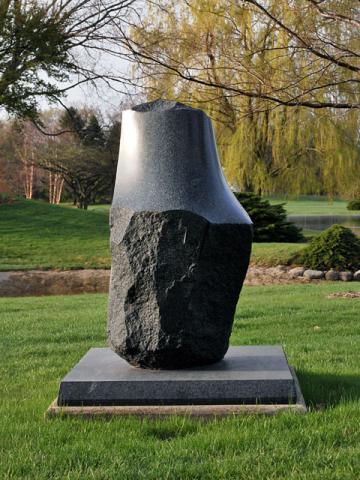Ancestor

Masayuki Nagare, a modernist sculptor and architect who called himself an old-fashioned samurai, was born in 1923 in Nagasaki, Japan. After a short period in Tokyo, where he spent more time at the homes of craftspeople than in school—it was the beginning of his immersion in traditional Japanese aesthetics--Nagare’s father enrolled him at a Zen temple school in Kyoto. There the artist practiced Zen Buddhism and became interested in Japanese swords. Afterwards, Nagare enrolled at Ritsumeikan University, of which his father was president, and studied religion as well as traditional arts and crafts. World War II prompted Nagare to enlist in the Imperial Japanese Navy, where he served as a Zero fighter pilot from 1943 to 1945. Following the war, the artist refused to purchase his university diploma, a common practice for returning soldiers, and instead traveled through Japan for a period of seven years, living with farmers and seeking out artisans to learn about their lives and their crafts. Nagare visited the United States for the first time in 1962, and was invited the next year to build the stone walls for the Japanese Pavilion at the New York World’s Fair. Since then he has created a multitude of sculptures, both small and monumental in size. Until his death in 2018, Nagare worked and resided on the Japanese island of Shikoku.
Masayuki Nagara believed that stones embody spirits. After selecting a stone, he allowed it to dictate the sculpture’s form, rather than imposing a form on an unyielding material. Given his religious background and spiritual beliefs, it is not surprising that Nagare’s first sculptures were inspired and based upon the Jizos, which are the Buddhist guardian deities of children. Later, his works reflected on the timelessness of life; he often created sculptures that, although abstract, are reminiscent of traditional Japanese forms. Nagare often created sculptures from granite, leaving part of the stone rough and untouched, while polishing other parts to a high finish. This method creates a peaceful equilibrium that nonetheless exudes energy. His sculptures beg to be touched, and Nagare meant them to be fully experienced.
Ancestor is a good example of the use of warehada. It is composed of harmonious textural contrasts. The piece swiftly translates smooth into rugged and back, while playing with concave and convex spaces. The form’s oppositions provoke a desire to touch, bestowing the sculpture with a suggestive sensuality. Ancestor is evocative, as the name suggests, of an ancient stone imbued with spirituality and history, watching out over its surrounding environment. Nagare meant his sculptures to be placed in natural sites, as it is in these settings that the works most clearly embody their spirit.
